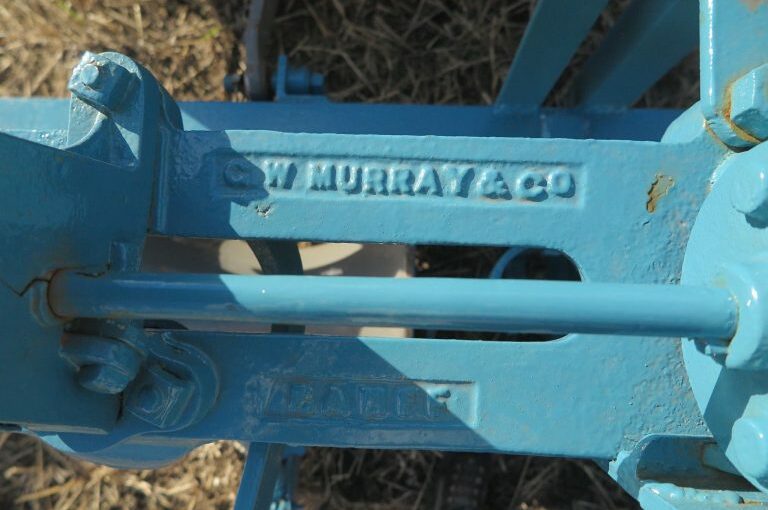One of the important innovative implements and machines of the 1880s was the patent potato planter invented and made by G. W. Murray and Co., Banff. This was developed over number of years in the 1870s. By 1880 it had been improved further.
It was exhibited and trialled in Scotland, England and in other major trials throughout the world. In April that year it was reported “beyond all question the best and most complete potato planter in the world, having been awarded the highest honours at every trial, not only in this country, but in Germany when in competition with the greatest number of planters ever shown at a time.” On 25 May 1881 Murray advertised in the Scottish agricultural press that “potato planter has beaten every known planter in the world, taking the highest award at every competition, including the Royal Agricultural Society of England’s first silver medal.” Awards included the “Highland and Agricultural Society’s Gold Medal, The Royal Agricultural Society’s Silver Medal, The Highland and Agricultural Society’s £10 prize, The Highland and Agricultural Society’s £5 prize.” Other international awards included Port-Elizabeth Exhibition (South Africa), 1881, and the Grahamston Exhibition (South Africa), 1881.
The esteem of this planter was recorded in a wide number of reports of trials. These included ones arranged by local agents such as James Payne, Thornhill, Dumfriesshire, and J. D. Allan & Son, Culthill, Perthshire. One report of a trial in April 1880, recorded in the Galloway news, 16 April, not only noted the importance of this machine but also provided a description of it. It is quoted at length:
“Trial of potato planter
On Tuesday last a trial of Messrs G. W. Murray and Co’s patent potato planter took place on the farm of Mouswald Grange, occupied by Mr Todd. This implement is very ingenious in construction, but is worked with the greatest simplicity and ease. The hopper containing the roots is formed with two pockets, and the front is made with open bars to allow of dirt and dust falling through. Through the bottom of each pocket passes an endless chain made up of a series of cups. These chains pass up the front of the hopper, over two wheels at the top, and then descend outside the hopper through two trunks, and over two wheels at the bottom. The upper face of the cups is circular and recessed, the size and form being arranged so as to hold only one root. From this face the cup falls away until it terminates with a flat tail, and on the other side is a hook. At the upper end are cast two lugs, with a pin between them, and the chain is made up of a series of these cups hooked together. The pitched wheel, around which they turn, is driven by gearing from the driving wheels of the implement and the speed can be regulated by means of chain wheels. As the chain travels up the inclined face of the hopper, each cup carries with it a root, which is tipped over in the trunk as the chain passes over the wheel, and is carried down with the chain to the bottom of the trunk, where it is discharged into the furrow. The clogging up of the cups by dirt is effectually prevented by the tail forming part of each link, because, as the chain passes around the wheel, the tail of one link is thrown through the slot in the face of the adjacent one, and dislodges. Anything that may have been deposited there. The carrying wheels of this machine are formed of two wrought-iron bands placed about 6 inches apart, and connected at intervals by slightly concave bars. The patentees have been working on the implement for the last six years, and they are to be congratulated on having at last produced an article as near perfection as can possibly be conceived. The one we saw at work on Tuesday is the first in this district, and it speaks highly for Mr Todd that he has had the enterprise, in these dull times, to introduce the novelty. That the machine will very soon do more than pay itself cannot be doubted, judging from the immense saving of time and labour which it effects. It is beyond all question the best and most complete potato planter in the world, having been awarded the highest honours at every trial, not only in this country, but in Germany when in competition with the greatest number of planters ever shown at a time. During the short period that it has been offered to the public no fewer than fifty-five had been sold into Perthshire alone, and the brief trial which we witnessed was sufficient to convince any one of its practical utility. The machines can plant eight acres a day; they are made to suit different sizes of drills, and the one at work was a two-row one, and can plant twelve, ten, or eight inches apart. The work done was of the most satisfactory character, the seed being planted with a degree of regularity that could not have been surpassed by hand planting. The implement was tried with both whole and cut potatoes, and it exceeded the most sanguine anticipations-indeed, so much was Mr Todd pleased with it that he at once became its proprietor, and we have no doubt its popularity will soon increase in this district. Mr Murray. Along with his agent in Dumfriesshire, Mr James Payne, Thornhill, personally superintended the trial.-Dumfries herald”
Keen readers will note some similarities to later potato planters: the use of cups to hold the potatoes (cut or uncut) as well as chain linkages. Indeed, early images of the planter used in adverts, show a machine that looked very similar to later models introduced in the later nineteenth and into the twentieth century.
